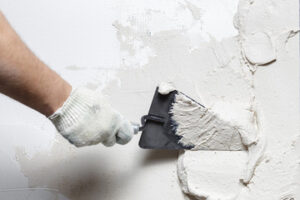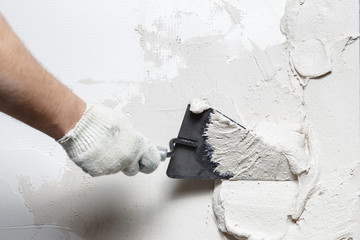Stucco Repair Philadelphia is a great do-it-yourself project for minor damage to stucco. You can fix small cracks, less than 1/16th of an inch, using caulk and paint.
The repair will also prevent moisture from penetrating the wall and potentially causing rot, mold, or structural framing damage. However, repair is only a temporary solution and doesn’t solve the underlying problem.
Hairline cracks in stucco are a common and fairly harmless issue. However, they can widen over time, laying paths for moisture to seep into the wall, which can cause untold damage to the structure. This damage may include mold, wood rot, peeling paint, and more. The best way to deal with these cracks is to use a caulking product to fill them.
For thin cracks no wider than a quarter inch, you can use a sand-textured acrylic exterior caulk and simply apply it to the cracked area. It’s important that the caulk be pressed against the crack firmly enough to hold it. Also, be sure the crack is completely dry before trying to seal it again.
Once the caulking is pressed against the crack, you should press some coarse sand or fine gravel into it. Be careful not to make it too deep, but deep enough that a layer of sand or gravel adheres to the surface of the caulk. Next, let the caulk cure for 24 hours and paint over it in a color that matches your house. Once the paint is on, the sand or gravel will hide any trace of the repair.
For cracks larger than a quarter inch, it’s best to hire a professional because they can assess the area and determine why the stucco cracked. They can then address the issue to prevent it from happening again in the future, such as by reinforcing the area, adding expansion joints, or installing a weep screed. They can also mix fresh stucco to fix the cracks and color-match it to your home.
Leaks
When water seeps into a stucco wall, it can cause mold, wood rot, soak insulation, and lead to structural damage. Most people assume that cracks are the main way water enters a stucco wall, but there are many other ways moisture can come in. Some of these spots are easy to miss, but a little time and effort can reveal them.
Aside from the obvious water stains on walls, you should also look for drywall that feels soft to the touch or that is pulling away from the stucco. This indicates that there is a lot of moisture in the wall and that it may be causing serious damage to your home from the inside out.
Another place to look for moisture problems is in the window caulking, as water tends to run down these areas. If you find gaps or cracks in the window caulking, it’s important to have them replaced to avoid water intrusion and possible future costly repairs.
Finally, you should also pay attention to the condition of the stucco itself, especially if it is old and worn. Chipped, torn, or pulled-apart stucco is a clear sign that there are issues underneath, and it may be worth calling a professional for a diagnosis.
A professional can take a sample of the damaged stucco and test it for moisture, salt efflorescence, bacteria, or other contaminants. They can then recommend a repair plan and schedule for the work. Often, the best course of action is to repair the damaged area by patching it with a high-quality exterior stucco material. The patch should be thoroughly cured and covered with a plastic sheet before being painted.
Mold
While stucco is an excellent choice for exterior walls, it can be susceptible to mold growth. Molds thrive in moist environments and can quickly damage stucco if left unchecked. Molds can also hide in the smallest cracks and crevices of your exterior stucco. If you think you have a problem, call a stucco repair professional immediately for an inspection.
Mold is not only unsightly, but it can be hazardous to your health if you breathe it in. If you have a severe problem, it may be necessary to remove and replace your exterior wall.
Stucco and EIFS are both easy to clean with a pressure washer, but be careful not to use too much water, or you could strip away material, particularly with the softer EIFS. Use a setting of low to medium pressure, start cleaning at the top, and work your way down. Make sure to check the surface of your stucco for chipping and flaking as well. If you do find these, then make sure to repair them before beginning to prevent further moisture intrusion.
If you have a stubborn stain that isn’t responding to washing, try using a mixture of water and regular dish soap or oxygen bleach (remember to be cautious when using chlorine bleach around plants). Scrub the area in segments, applying mild but firm pressure. Rinse the wall thoroughly with water afterward.
If you are finding larger cracks in your stucco, then it’s important to have a contractor examine them. Larger cracks aren’t just a nuisance; they can let in moisture that will further deteriorate your stucco and lead to costly repairs down the road. A skilled stucco contractor can patch these cracks with a premixed stucco repair compound and texture it to match the surrounding stucco.
Mildew
Mold, mildew, and algae growth in your stucco can make it look ugly and cause water damage within the walls. Often times, this is the result of moisture issues that are left unchecked. It is important to regularly inspect your stucco to catch any cracks, chips, or tears that might let water in and wreak havoc. This can lead to costly repairs and mold problems that should be taken care of right away.
Mildew stains are typically a dark gray or white and are usually found in areas where moisture accumulates on the surface of your stucco wall. This can be caused by leaking roofs or overhangs, rainwater collecting on the wall, or simply high humidity. Stubborn stains can be scrubbed with a store-bought cleaner or a mixture of bleach and water (like borax) that is safe to use on your stucco. Always test any cleaning solution on a small portion of your stucco to ensure that it won’t affect the color.
If you find any cracks or chips while cleaning your stucco, it is important to get these repaired right away before washing the surface. Washing your stucco without repairing any damages first can cause water to seep into these cracks and create an environment that is perfect for mold, mildew, and algae to grow in. In addition, cracks can make it easy for water to penetrate the wall and weaken wood framing, windows, and more. Cracks and chips can be fixed with exterior acrylic caulk that matches the shade of your stucco. This is available at most major home improvement retailers and local stores. You can also add sand or other gritty material to the caulk to mimic the texture of your stucco.
Animal Damage
Stucco is strong enough to be used on bridges and skyscrapers, but it can also be easily damaged by animals. Squirrels and woodpeckers are known to eat stucco, and if left unchecked, they can cause thousands of dollars’ worth of damage. Stucco can also be damaged by mice, rats, and other rodents. If you notice rodent activity in your stucco, it is important to have a professional inspect the area and determine the source of the problem.
Termite damage is often caused by moisture penetration in stucco and can be difficult to detect. If you notice any cracks or blisters in your stucco, it is recommended to have a professional do an inspection to identify the source of the problem and repair it.
Moisture-related conditions can be prevented with proper drainage and the installation of downspouts, gutters, flashing, and grading to properly direct water away from the stucco. In addition, a regular inspection with a masonry contractor can help identify problems that could become serious in the future.
With the exception of impact damage, all types of stucco-related damage are preventable if the underlying conditions are corrected and monitored. This is why it is essential to have a reputable, experienced masonry contractor perform an inspection and make the necessary repairs. Stucco is a long-lasting, durable cladding material that provides many benefits to residential and commercial properties, including aesthetics, energy efficiency, and structural stability. By performing a visual inspection and having a masonry company complete an inspection with invasive and non-invasive moisture meters, borescopes, and thermal imaging, you can be assured that your stucco will remain safe and sound for years to come.

